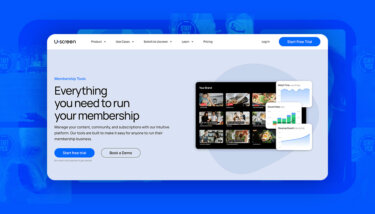Learning how to create a membership site is key to stability in content creation. The membership business model allows you to earn a predictable stream of revenue, deliver high-value content, and cultivate thriving communities.
Our 2025 Video Membership Report shows that membership sites are growing in popularity through apps. Last year, people consumed 1.5 billion minutes of content through mobile and TV apps for membership sites, nearly doubling web-based content consumption time in the same year.
In this guide, we’ll break down what a membership site is, benefits, and nine simple steps to start one with some examples.
What is a membership site?
A membership site is a gated online platform that provides exclusive content, services, and community to paying members.
The exclusivity is the key component. Think of it like a private clubhouse for your superfans. Paying members gain access to high-value content that can’t be found anywhere else and the keys to a dedicated community for something they’re deeply passionate about.
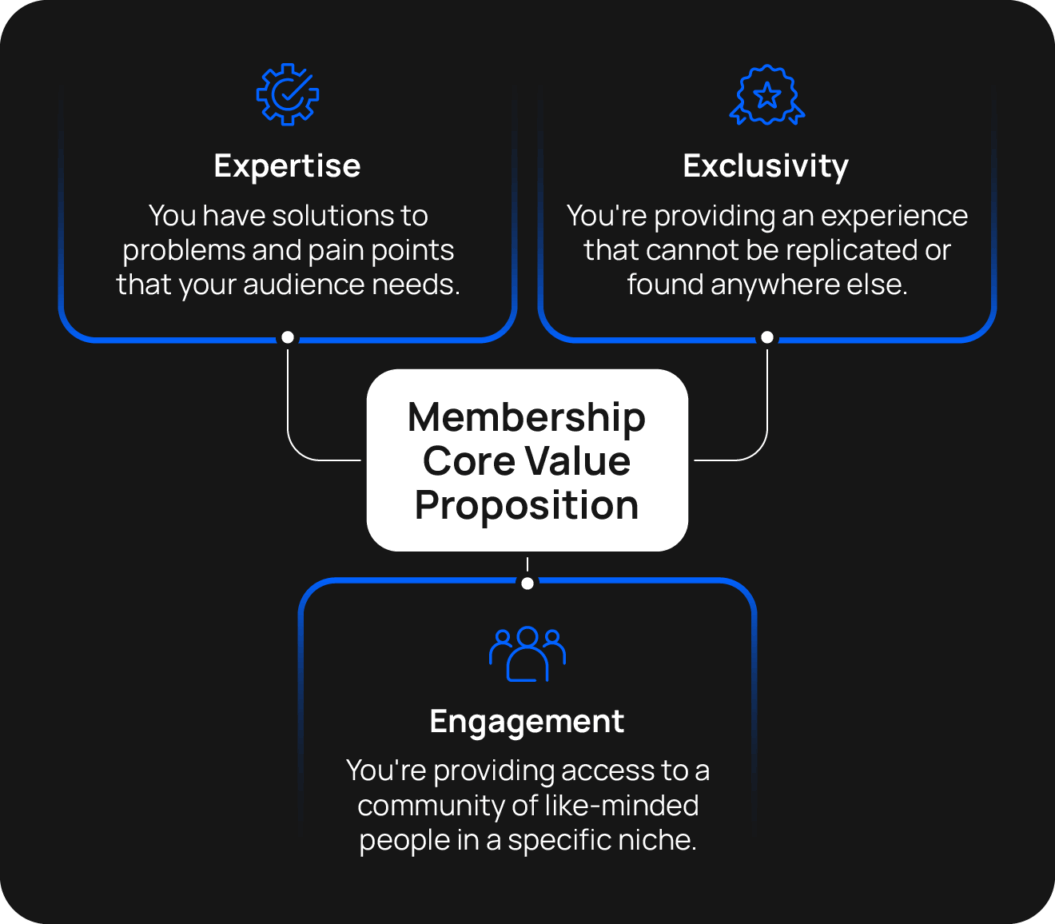
You can use membership website software to build an exclusive hub that converts passive viewers into paying customers. It’s the ultimate method to take more control over your business, build a reliable revenue stream, and turn your passive followers into an active community.
This is your method to stop worrying about algorithms and inconsistent income, and start building your business on your own terms.
What makes up a membership site?
There’s a massive variety in what membership sites actually look like, and that’s the beauty of it. You can construct your membership to align exactly with your business model, content offerings, monetization strategy, and more. However, there are a few key features that all membership sites should include:
- Community features: Your membership site should create a natural sense of community among its members. Member profiles, discussion boards, and chat rooms can help members network with one another and engage with you in ways they couldn’t on any other platform.
- Interactive elements: Interactive elements encourage your members to invest themselves in the community they’ve paid to join. For example, some content creators offer polls that allow viewers to directly influence the content they create or host Q&A sessions that give members direct access to them.
- Gated content and level-up capabilities: The content posted in your membership site should be exclusive to the members who paid to access it. You can offer different levels of membership, starting with a free or budget option and moving up to progressively more expensive tiers. This makes it easier for new members to join and creates a clear path to upsell existing members looking for more value.
- Content tools: At a fundamental level, your membership site should have the tools to deliver a variety of content directly to your audience, from videos and newsletters to live streams and virtual events. Without robust content delivery features, a membership site might as well just be a paid forum.
Benefits of creating a membership site
Membership sites bring a level of stability, control, and depth to creator brands that can’t be replicated anywhere else.
Build recurring revenue you can count on
Membership sites offer predictable, recurring revenue through subscription fees. All you have to do is multiply your total subscribers by their payment amount, and you’ll get a fairly accurate picture of your minimum monthly or yearly earnings.
This stable floor breaks your reliance on unpredictable systems and one-off sales, making it much easier to create accurate forecasts, deliver high-quality content, and scale your business without the constant pressure of chasing the next product launch or viral clip.
Own your platform and your audience
A membership site lets you control your brand. You set the rules, you design the customer experience, and most importantly, you own the audience data so critical to measuring success.
This allows you to create, optimize, and monetize your brand without having to stress about the specter of sudden changes. You’ll spend less time worrying about what an algorithm demands and more time curating content and experiences that deliver maximum value to your human audience.
Create deeper engagement and community
Membership sites offer a platform to build stronger connections with and among your customers. Paying members aren’t just passive followers or occasional viewers; they’re superfans who are truly passionate about your brand and are willing to talk to you and others about it.
By giving your members a direct connection to your brand and one another, you’re creating loyal customers who are more likely to keep coming back for more and spread the word about what you do. Every community interaction within your membership site is a valuable insight you can use to shape the future of your business.
How to set up a membership site: 9 steps
With all those benefits in mind, you probably want to get started right away. But membership website development is a very involved process, and you might not have the time to go down a rabbit hole of hundreds of Google searches.
We’re here to spare you some of that investigative work and point you in the right direction. Here are nine straightforward steps you can take to set up your membership site:
Choose your niche and audience
The first step to creating your membership marketing funnel is identifying your ideal member.
Milou Pietersz, content creator and founder of Simply Multimedia, says, “You can gather this information by looking at who is following you on social media and engaging with your content. Sending out surveys is another way to collect these insights.”
Once you’ve identified who they are, what their pain points and goals are, and which competitors they might be looking at, ask yourself the following questions:
- What problems are you solving? You should be offering unique solutions to specific problems that can’t be found anywhere else.
- Who are you solving problems for? It’s normal to want to cast a wide net, but in this case, you want to find a niche audience.
- What content or access will members pay for? People paying to join a membership site expect a unique experience carefully curated to meet their needs. Make sure the content and features you’re planning to offer satisfy those criteria, or you might encounter higher churn rates.
Pro tip: Avoid generic, broad-stroke messaging and content. Aim to solve a specific problem for a specific type of person.
2. Choose your content formats
Your content is the bread and butter of your membership site. Make sure it’s exactly what your audience wants.
Common video formats include:
- Online courses: A structured series of video lessons that teach members a specific skill or set of skills
- Live streams: Real-time video broadcasts with direct interaction between members and the creator
- Webinars: Live or pre-recorded sessions covering a topic, often accompanied by Q&A sessions, office hours, or feedback surveys
- Tutorials: Short videos detailing how to complete a task or use a tool
Text-based formats could include:
- Guides: A long-form article comprehensively covering a specific topic, meant to serve as a resource for reference
- Articles and blog posts: Written posts covering developments, updates, and relevant topics within the audience’s niche
- Newsletters: Regular content, news, and business updates, usually delivered in email form
- eBooks: Downloadable online books that dive deep into a subject relevant to the audience
As you think about the content formats you plan to deliver, you can get a better idea of the ideal platform for your membership site.
For example, if you’re planning to deliver a lot of video content, you might look for a platform with world-class video hosting features and native live streaming capabilities, like Uscreen.
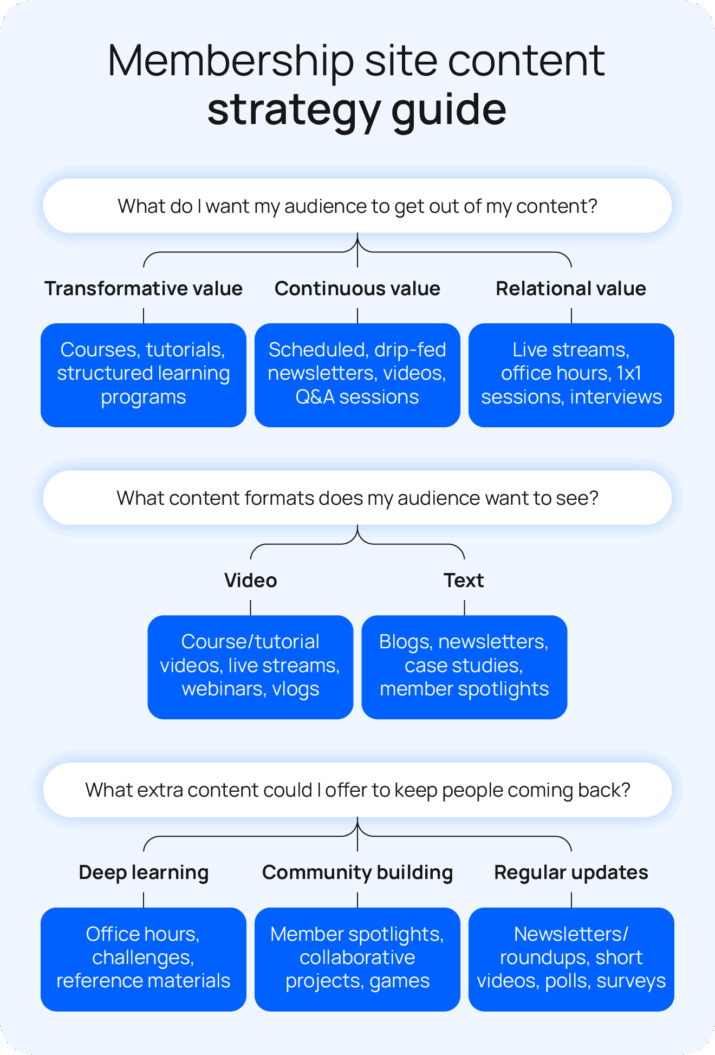
Pro tip: Consider hosting regular live streams to bring your audience together and build connections in real time. Uscreen customer data shows that regular live streams result in a 2x increase in revenue for membership sites.
3. Pick the right membership platform
When looking for the right membership site platform, you’ll have a lot of potential options to choose from, including:
- Uscreen: Uscreen is an easy-to-use platform that has every feature you need to build a successful membership site. With Uscreen, you can easily create paid memberships that include an on-demand Netflix-style video library, live streaming capabilities, flexible monetization options, and a community space. You can house all of this in your own branded app, which can lower your churn rates by 15% and increase watch time by 25%.
- Kajabi: Kajabi is a great platform for creators seeking to launch courses and digital products. It’s an all-in-one solution that has everything you need to create, market, and sell courses without using third-party tools, and comes with the ability to create mobile apps to deliver your content. With Kajabi, you’ll also be able to implement community features like help centers and webinars that help keep members engaged over time.
- MemberPress: MemberPress is a WordPress video membership plugin that offers an incredible number of features and customizability, from course creation and content gating tools to customizable checkout and community features. It essentially allows you to create a membership platform within your existing site, making it ideal for creators looking to avoid the stress of launching with an unfamiliar platform.
- Podia: Podia helps budget-conscious creators launch courses, known for its zero transaction fee policy. In Podia, you can upload courses, downloadable content, and webinars in one place, at your own pace. You can also use native marketing tools, member communication options, and basic community features to proactively drive engagement with your content.
- Patreon: Patreon is well-known and trusted for its ease of use, flexibility, useful integrations, and straightforward payment processing. It’s a helpful tool for those looking to become full-time creators with sustainable, recurring revenue. That said, those looking for more advanced features or more freedom might find better value in an alternative option like Uscreen or Podia.
To pick the right one, ask yourself a few questions before making your decision, such as:
- What tech experience does this platform require? If you’re very tech savvy, you might find value in a platform with a learning curve that most would find too intense. If you’re not too tech-inclined or unsure where you stand, there are plenty of other solutions that feature an easy setup process for a high-impact layout.
- What monetization models does this platform support? Make sure your monetization model is compatible with your platform of choice. For example, if you want to launch regular paid live streams but the platform you’re considering doesn’t allow that, don’t settle. Pivot to an alternative that does.
- What community features does this platform have? Membership sites aren’t just about content and monetization. People who pay for these are also seeking out a community. Select a platform with robust community features that allow you to deepen member engagement beyond the surface level.
- Is this platform scalable? You should choose a platform that can handle growth or support extra features down the line. The more features and content formats you can add, the better. You may not need or use all of them immediately, but having those options built in can save a lot of hassle down the road.
Pro tip: Choose a membership site platform that suits not only your current needs but also your future possibilities.
4. Set your pricing strategy
Setting a price can feel like a high-stakes guessing game, but we’re here to help you get it right. When deciding on a membership pricing strategy, you’ll want to consider a variety of factors, including:
- Your revenue target: In an ideal scenario, how much do you want to be making on a monthly basis from your membership site? How many paying members do you expect to have? Price to match your target as closely as possible.
- Your competitors: How are competitors in your niche pricing their membership fees? Consider adjusting your strategy to match or beat theirs.
- Your audience size: Are you serving a huge, broad audience or a smaller, hyper-specific niche? Price accordingly. Generally speaking, the broader your audience, the lower the fee.
- Content value: Are you solving pain points, promising tangible results, and providing exclusive insights? If so, your content value is high and could command a higher price point.
- Content quantity: How much content are you offering from the get-go? Are you consistently releasing new, curated content on the platform? The more provided and promised, the higher the value.
Rest assured: You don’t have to do all of this yourself if you don’t want to. Uscreen offers a free membership pricing tool that does the hard work for you, giving you an accurate target price backed by nearly 10 years of market data. No more worrying if you’ve set your price too low or too high.
At a high level, your options for pricing models include:
- Flat-rate, fixed-price subscriptions: This is a recurring, fixed fee that members pay on a monthly or annual basis for continuous access to your entire membership site. This option is common, familiar, and easily understood by broad audiences, providing you with a predictable income stream.
- Tiered memberships: These are segmented membership tiers, each with its own price and level of access. This lets creators offer content and prices that fit different budgets and interests while upselling active members into higher tiers.
- Pay-per-view: Fees issue access to individual pieces of content rather than the entire website. This way, members can pay exclusively for the specific content they’re looking for, while creators can maximize their revenue on premium content.
- One-time purchase: This is a single, upfront purchase for permanent access to your membership site or a specific part of it. This option appeals to customers who want to access your content but don’t want to commit to a recurring fee.
Pro tip: Consider free trials or intro offers to reduce friction. According to Uscreen data, 52% of people who sign up for a free trial convert into monthly subscribers after the trial ends.
5. Build and brand your membership site
You’ve worked hard to build a brand that your audience has come to know and love. Make sure your site feels like home to them when they log in. Consider the following design fundamentals:
- Logos: Is your logo displayed prominently on the website? When people click on your site, they should immediately know it’s yours.
- Colors: Do the website’s colors match your brand? Try to keep your color palette consistent with your logo and brand colors for a unified identity.
- Imagery: Does the imagery featured on your website align with your brand? Double check that images seamlessly fit your brand and aren’t jarring to the user, with matching colors, filters, and overall aesthetic.
- Tone: Does the website copy align with your brand voice? Make it consistent with your other platforms. Your audience is here for your voice.
The most important thing to keep in mind is user-friendliness. Your site should be simple, straightforward, and easy to navigate, yet still rich in visual appeal and functionality.
Some platforms, like Uscreen, offer customizable templates that make user-friendly, engaging design easy to implement. Looking for inspiration? Check out some examples of platforms built using Uscreen templates.
Pro tip: Consider including personalized dashboards, content recommendations, a search bar, and gamified features like leaderboards and badges. These design elements boost engagement and encourage members to log back in on a regular basis.
6. Add your content and organize it
If you’re adding a membership site to your business model, you need to fill it out with high-value content that your target audience is willing to pay for. There are a couple of ways you can go about this:
- Full-access model: Upload and publicize all your content at once, giving members complete access to your entire library.
- Drip-feed model: Upload all your content, but only publicize the initial round, releasing further batches on a routine schedule optimized to keep people coming back.
No matter which model you choose, structure and organize your content around clear themes or learning paths. This makes it easy for users to navigate your content and focus on what interests them. You’ll want to get into the habit of organization early, because it only becomes more important as your library grows.
Pro tip: Allow users to create their own playlists from the content in your library. This feature allows users to further personalize and curate their membership experience around what they value the most.
7. Set up payments and user access
Integrate a payment system into your membership platform by setting up an account with a standard processor like Stripe or PayPal. Then, find the payment provider options section in your platform and follow the instructions to connect it.
If your platform offers built-in monetization options and checkout tools like Uscreen, the process is usually fairly simple, but it might take a few days to complete. Once you’ve configured your payment processor, you can start monetizing your membership site exactly how you want.
You’ll also need to set member permissions based on their subscription type. If you offer different subscription tiers, make sure each tier gets access to exactly what the plan promises — nothing more, nothing less.
Pro tip: Consider integrating more than one payment system so members are more likely to find an option they’re familiar and comfortable with. If you notice that lots of users are asking about a specific payment method your site doesn’t have, try adding it to accommodate the popular preference.
8. Launch and promote your membership site
Before you publicize your membership platform, you’ll want to take it through a full launch process to hit the ground running. This is critical to ensuring you get returns for all the time, money, and resources you’ve invested in your site.
Start by thoroughly testing your website internally and with a small focus group of beta testers. This helps you resolve errors and refine the user experience before taking it to market.
Milou Pietersz emphasizes the importance of beta testing:
“Always treat your first launch as a beta launch, and keep refining from there … Once you get your first members in, they will tell you what they need and what they’re looking for, helping you to refine as you go.”
While you iron out all the kinks behind the scenes, create an email waitlist and use every outlet available to promote it. This will ensure members sign up the moment it goes live.
Tap your current audience through email marketing (including newsletters and updates), social media campaigns (especially short-form videos), and web content (like blogs and newsletters). Think of these like warm leads. These people already know your brand and are likely to sign up if they want more.
Reach out to your target audience through paid ads, media placements, and collaborations that speak to their problem and present your solution. Keep in mind that these potential users are more like cold leads. They may not know your brand yet, so you’ll need to carefully tune your message to pique their interest and prompt action.
Mackenzie Myles, customer success manager at Upscreen, shared her insight on how to market your membership to these two distinct audiences.
“The way you promote your membership should differ based on whether you’re speaking to loyal fans or cold leads”:
- Loyal audience: Lean into exclusivity, early-bird pricing, and community-building.
- Cold audience: Focus on education, brand familiarity, and proof of value before selling.
Pro tip: Set up a referral rewards program that incentivizes members to invite their friends. Let your members handle some of the promotion work for you through word-of-mouth marketing!
9. Keep members engaged and grow
Once you’ve gotten your audience to pay the access fee, it’s your job to give them a reason to stay (and keep paying). Community features like discussion boards and private groups allow members to connect with one another and encourage them to stick around for the people they’ve met, not just the brand and content they value.
Still, don’t leave engagement all up to the user. You’ll want to be proactive in keeping your members invested and churn rates low. Rob Balasabas, head of partnerships and community at Uscreen, encourages:
- Steady content drops, including exclusive workshops/training, Q&A sessions, and behind-the-scenes insights
- Consistent personal interactions, like replying to post comments from members
- Frequent feedback loops to gather and implement member suggestions on the website
Examples of membership sites
Over the years, people have gotten membership website design down to a science. There are countless examples of high-converting membership sites out there for just about every niche you could imagine. We’ve worked with and analyzed thousands of membership sites, but here, we’ll highlight some examples that really stand out.
Find What Feels Good
Find What Feels Good (FWFG) is a Netflix-style yoga streaming service that makes advanced yoga classes, meditation guides, and wellness content accessible to over 46,000 monthly subscribers.
Since migrating to Uscreen, FWFG has excelled at attracting and retaining new members, observing a 201% increase in membership and a 6.72% increase in time spent interacting with content monthly.
Using Uscreen’s integrated community features, FWFG has been able to engage its community more proactively, interact with them on a deeper level, and create a stronger sense of connection among users. This has reduced churn rates and increased customer loyalty, leading to a 4.5% increase in monthly recurring revenue.
“We had our community on another platform, and it had kind of taken on a life of its own. The fact that Uscreen had a built-in community was just like a dream come true,” said Chris Sharpe, co-founder and COO of Find What Feels Good. “So now it’s much easier to manage, and we’re starting to see that as a great way to reduce churn.”

Curious to know more about exactly how they achieved these results? Read our case study to learn how FWFG proved what’s possible when you put your community first.

Studio Bloom
Studio Bloom is a fitness and wellness site offering workouts, specialized programs, and expert advice for pregnant and postpartum women.
Studio Bloom’s homepage is a strong example of what a clear value proposition looks like. It includes all of the site’s offerings and speaks directly to what’s most important to its niche audience with straightforward problem-solution explanations, success stories, and empathetic language.
Once you’ve paid for access using one of its three subscription options, you’re greeted with a well-organized library of over 600 pregnancy-safe workouts, all of which can be accessed through mobile and TV apps. You’ll also find a thriving community forum where members connect, support one another, and enjoy frequent input from expert voices.
This site has grown to over 5,100 paying members with strong engagement metrics, making for over $1 million in annual recurring revenue.
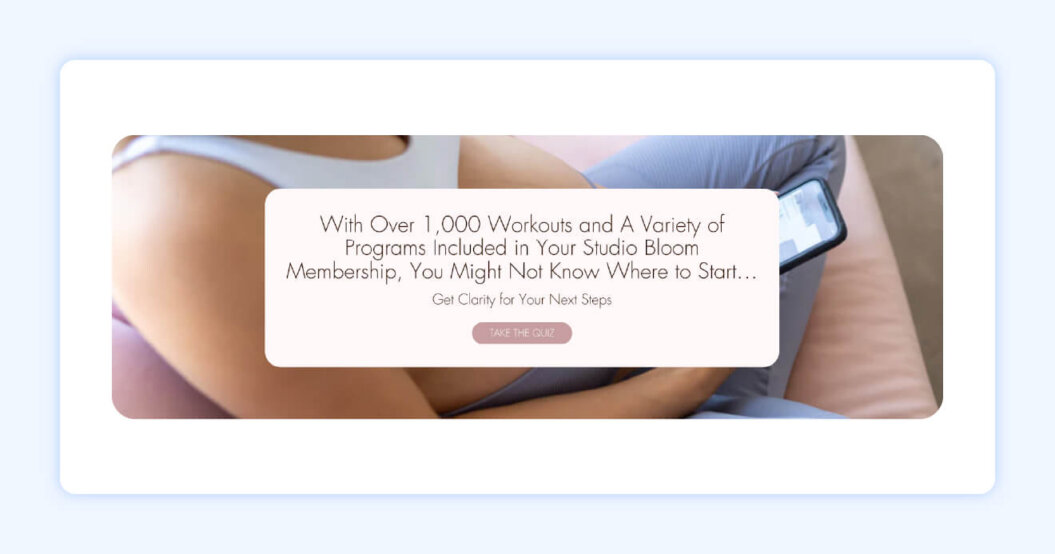
M/BODY
M/BODY is a video streaming platform offering hybrid fitness training content to fitness enthusiasts seeking barre, dance, and yoga workouts.
M/BODY has mastered the art of smooth conversion, allowing users to browse the library of over 400 carefully categorized workouts and live classes before they even pay, so they know exactly what they’re getting ahead of time.
With access to workout previews, sample videos, a mobile app, and a seven-day free trial, M/BODY combats buyer hesitation through radical transparency, making its members feel secure in their purchase.
Using this method, M/BODY has put its own stamp on a great membership site idea and earned standout performance, transforming a single physical studio into a global platform.
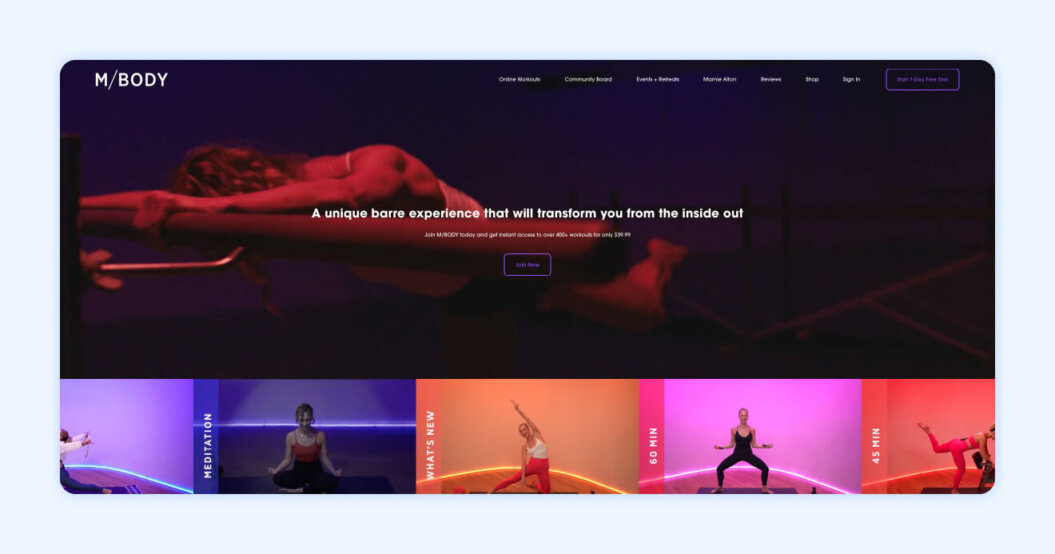
Filmmakers Academy
Filmmakers Academy is an education and mentorship platform for aspiring and active filmmakers.
This membership site provides users with direct access to award-winning industry professionals who’ve provided 900+ hours of in-depth lessons, courses, and podcasts alongside personalized coaching and live events.
The value proposition is obvious: Filmmakers in training get to learn from Emmy recipients, the people who are the very best at what they do. This is an exceptional opportunity that most people in the industry won’t find in their everyday lives.
Filmmakers Academy takes this expert access a step further with strong community features that allow peers and mentors to network, share insights and advice, and even share employment opportunities.
Since migrating to Uscreen, Filmmakers Academy has achieved a 180% increase in membership, growing at a steady 8% rate month over month.
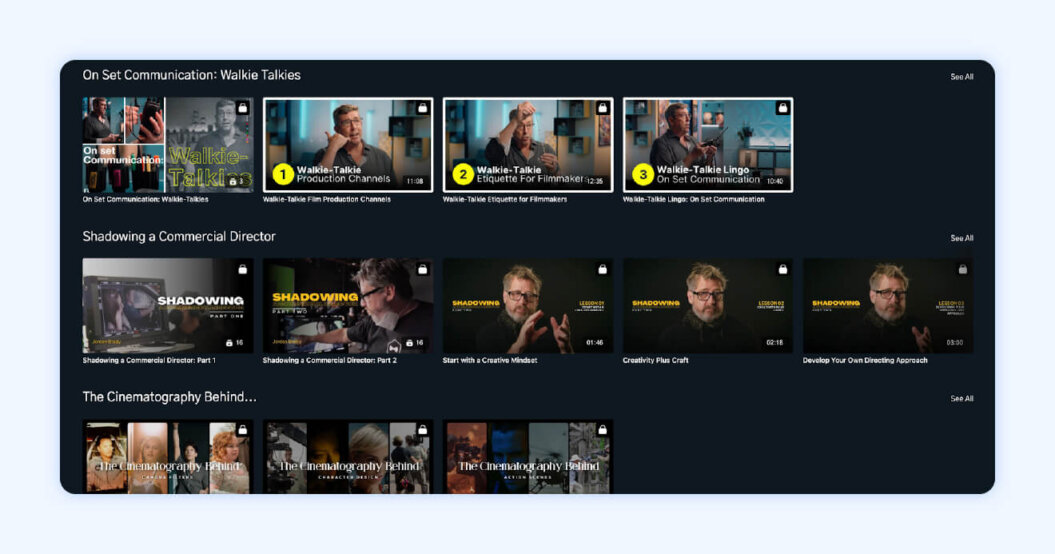
Ready to launch? Your members are waiting
Learning how to create a membership website can feel daunting, but it’s not as hard as it seems. You don’t have to be tech savvy to start — just focused on providing value. By following the nine steps in this guide, you’ll be well on your way to taking control over your business, earning recurring revenue, and tapping into the growing power of membership sites.
There’s no reason to wait. Break your reliance on unpredictable algorithms and unstable environments now. Book a free demo with Uscreen to visualize what your platform could look like and discover your untapped earning potential.
Yes, membership sites can create a stream of predictable, recurring revenue for creators. The specific amount of money you make depends on your pricing model and number of members.
The cost of building a membership website can be free or cost up to tens of thousands of dollars. How you choose to set it up determines the specifics. You’ll also need to factor in recurring maintenance and development costs to keep your site up and running as intended.
Start by defining your needs, then research the available plugins and compare the features on offer. Select the plugin with the features that best align with your defined needs.
Common mistakes you should avoid when setting up your membership site include:
Lacking a clear value proposition
Failing to identify a specific target audience
Neglecting community engagement and interaction
Implementing an unsustainable pricing model
Failing to give members reasons to keep paying for your site
Yes, there are multiple legal considerations when setting up a membership site. These include contractual agreement procedures, data protection and privacy laws, intellectual property laws, and various consumer protection laws, all at the federal, state, and even international level.
It’s highly recommended that you seek professional legal counsel when setting up your membership site to ensure total legal compliance and protection.


